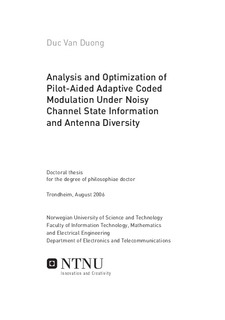| dc.contributor.advisor | Øien, Geir E. | nb_NO |
| dc.contributor.author | Duong, Duc Van | nb_NO |
| dc.date.accessioned | 2014-12-19T13:29:55Z | |
| dc.date.available | 2014-12-19T13:29:55Z | |
| dc.date.created | 2006-12-19 | nb_NO |
| dc.date.issued | 2006 | nb_NO |
| dc.identifier | 126366 | nb_NO |
| dc.identifier.isbn | 82-471-8080-4 | nb_NO |
| dc.identifier.uri | http://hdl.handle.net/11250/249848 | |
| dc.description.abstract | The thesis is largely built on a collection of published and submitted papers where the main focus is to analyze and optimize single-carrier adaptive coded modulation systems with and without antenna diversity. Multidimensional trellis codes are used as component codes. The majority of the analysis is done with both estimation and prediction errors being incorporated. Both channel estimation and prediction are performed using a pilot-symbol-assisted modulation scheme. Thus, known pilot symbols (overhead information) must be transmitted; which consumes power and also degrades system spectral efficiency. Both power consumption and pilot insertion frequency are optimized such that they are kept at necessary values to maximize system throughput without sacrificing the error rate performance. The results show that efficient and reliable system performance can be achieved over a wide range of the considered average channel quality. Going from a single-input single-output system to both spatially uncorrelated and correlated single-input multiple-ouput (SIMO) systems, and further to an uncorrelated multiple-input multiple-output (MIMO) diversity system, is the evolution of the thesis. In the SIMO case, maximum ratio combining is used to combine the incoming signals, whereas the signals are space-time combined in the MIMO diversity system. The multiple-input single-output system comes out as a special case of a MIMO system. Besides the spatially uncorrelated antenna array, the effect of spatial correlation is also considered in the SIMO case. In this case, only prediction error is considered and channel estimation is assumed to be perfect. At first, the impact of spatial correlation in a predicted system originally designed to operate on uncorrelated channels is quanitifed. Then, a maximum a posteriori (MAP)-optimal “space-time predictor” is derived to take spatial correlation into account. As expected, the results show that the throughput is still lower than the uncorrelated system, but the degradation is decreased when the MAP-optimal space-time predictor is used. Thus, by exploiting the correlation properly, the degradation can be reduced. By numerical examples, we demonstrate the potential effect of limiting the predictor complexity, of fixing the pilot spacing, as well as of assuming perfect estimation. The two first simplifications imply lower system complexity and feedback rate, whereas the last assumption is usually made to ease the mathematical analysis. The numerical examples indicate that all the simplifications can be done without serious impact on the predicted system performance. | nb_NO |
| dc.language | eng | nb_NO |
| dc.publisher | NTNU | nb_NO |
| dc.relation.ispartofseries | Doktoravhandlinger ved NTNU, 1503-8181; 2006:157 | nb_NO |
| dc.subject | Adaptive coded modulation (ACM) | en_GB |
| dc.subject | Pilot-aided channel estimation and prediction | en_GB |
| dc.subject | Adaptive PSAM | en_GB |
| dc.subject | Adaptive transmission | en_GB |
| dc.subject | TECHNOLOGY: Information technology: Telecommunication | en_GB |
| dc.title | Analysis and optimization of pilot-aided adaptive coded modulation under noisy channel state information and antenna diversity | nb_NO |
| dc.type | Doctoral thesis | nb_NO |
| dc.source.pagenumber | 175 | nb_NO |
| dc.contributor.department | Norges teknisk-naturvitenskapelige universitet, Fakultet for informasjonsteknologi, matematikk og elektroteknikk | nb_NO |
| dc.description.degree | PhD i elektronteknikk | nb_NO |
| dc.description.degree | PhD in Electrical Engineering | en_GB |
